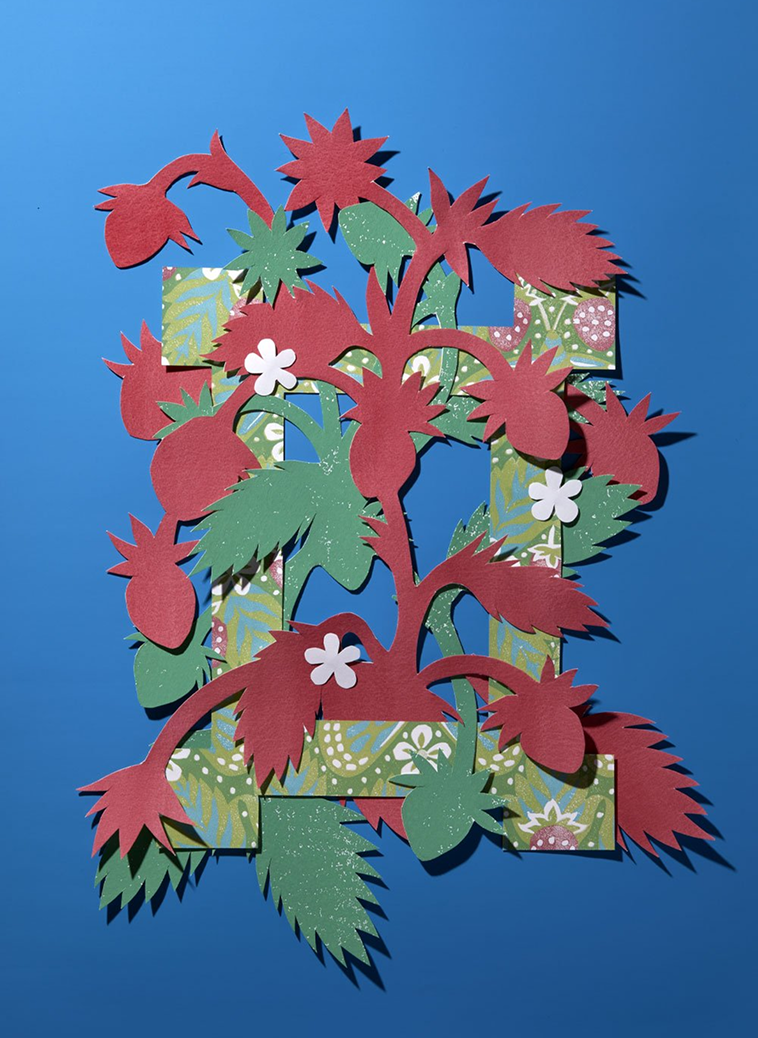Collections

Food Forest
Food Forest is inspired by food forests, groupings of native, perennial plants that center around fruit and nut trees. Imitating ecosystems found in nature, food forests feature edible plants that grow at different heights to maximize food production in contained spaces, such as small gardens. Combining sustainability and beauty, food forests consist of vegetation layers of fruits, nuts, flowers, and foliage. These little home orchards are feasts for the eyes and the table.
The Food Forest collection consists of three patterns: American Persimmon, Buffalo Poppy, and Leaflet. American persimmon trees are ideal fruit trees for food forests, and grow best when they’re accompanied by companion plants, including buffalo poppies and Virginia Strawberries. These two plants are featured in our American Persimmon design and are also the inspiration for our stand-alone patterns Buffalo Poppy and Leaflet.

Companion
Mazy Path is inspired by remarkable plants. As we expand our offerings to include textiles, we find inspiration in gardens as well. Gardens thrive when there’s a combination of diversity and interdependence. With an array of printed fabrics, our Companion collection adds variety and depth to the Mazy Path line. Companion’s fabrics (which are based on our wallpaper patterns Pawpaw, Hummingbird, Virginia Strawberry, Guava and Winter Wheat) are printed on 100% Belgian linen in Pennsylvania. With their supple hand, they hug the contours of furniture frames and flow as drapery.

Heirloom
The Heirloom collection explores remarkable plants grown from heirloom seeds. Seeds given the name “heirloom” have special characteristics, such as flavor, productivity, and resilience. Thanks to such attributes, these seeds are grown, saved and passed from one generation to the next. They’re open pollinated, meaning that they haven’t been hybridized or genetically modified, and so they reliably grow with the same traits year after year. This genetic consistency maintains the diversity of the world’s agricultural production and forms the backbone of our food system. In short, heirloom seeds have roots in the past, and they’re the tickets to our future.
And, just as family heirlooms- porcelain, silver, furniture- remind us of our history and our identity, heirloom plants do too. Our relationship with nature is indeed familial, and heirloom plants form the legacy we leave to our descendants; they are the treasures we pass forward.
Each design in this collection- Wild Ramps, Virginia Strawberry and Winter Wheat- has a singular story and a special place in American foodways and culture. Inspiration from French Domino papers to Arts and Crafts textiles to Delft tiles (all heirlooms in the conventional sense) gave form to Heirloom’s designs.

TREASURE TREE
The noted food historian, Michael W. Twitty, once referred to the pawpaw, a tree that bears America’s largest native fruit, as a “treasure tree.” This marvelous moniker is a fitting name for our new collection, a group of designs celebrating trees known for both their beauty and bounty.
Treasure trees feed us, keep us healthy, line our pockets, and protect us from the effects of climate change. Guava pays homage to the pink guava tree, the sweetest of all guava varieties. Elderberry is a paean to the Elder tree, coined by Hippocrates as nature’s medicine chest. Nickel Tree explores rare New Caledonian trees that flow with nickel-suffused sap. And Mangrove celebrates mangrove forests, dense clusters of mangrove trees that hug coastlines to protect them from tidal surges.
Treasure Tree is inspired by the work of contemporary writers, such as Richard Powers and David George Haskell, whose prose reveals the wonders of the arboreal world. To express our concepts visually, we found ideas for composition and technique in the work of early modern art movements, including the Arts and Crafts Movement, the Vienna Secession and Fauvism.

Community Garden
The designs in our Community Garden collection celebrate interdependent relationships in the natural world. Willow Talk features trees that support one another with the help of underground fungal networks. Hummingbird reveals how familiar flowers depend on the endurance of an ornithological marathoner. Coneflower demonstrates the resilience of a small southern blossom that came back from the dead once its habitat was protected. Pawpaw speaks to how North America’s only native tropical fruit has thrived in the understory of its arboreal neighbors. And Panel of Perception explores the yagé vine, poppies and fly agaric mushrooms, plants that open the doors to psychedelic experiences for humans and animals alike.
Community Garden is inspired by the work of contemporary writers, poets and scientists, including Michael Pollan, Margaret Renkl, Andrew Moore, Mary Oliver and Suzanne Simard. Through the lenses of consciousness, transcendentalism and biology, these leading thinkers have shed light on dynamic connections between plants, animals and humans. To give visual expression to these ideas, we looked to the work of early modernists, including Pedro De Lemos, Charles Burchfield and Edna Boies Hopkins.
Naming our first collection Community Garden is also fitting for our company; Mazy Path is the fruit of nurturing teachers, mentors, friends and family: community gardeners all.
